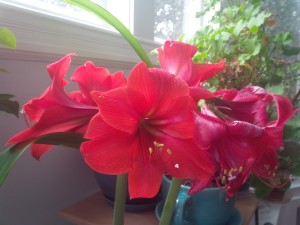The last of the tulip bulbs have been planted up in tubs, which means that it’s time to decorate for the holidays. I am ready to go, with visions of ribbon and pinecones dancing in my head.
At this time of year, when daylight hours have winnowed down to a precious few, I think brightening up interior spaces is necessary for mental health. Everyone should decorate according to their aesthetic, cultural and/or religious beliefs. Budgetary parameters are a given for most of us, though if you have a fortune that you have not gambled away on crypto-currency, the sky may be the limit.
My mother was such a lavish and frantic decorator that we called her “the Christmas Tornado”. I am more of a “holiday chipmunk”—I scurry around decorating bit by bit in the small available time increments that pop up in between all my other commitments.
My mother loved natural decorations—holly and other evergreens, poinsettias by the score, red roses and red carnations. Hers came mostly from the local florist; mine come mostly from the garden, or sometimes, the garden center.
I am lucky enough to have a couple of large holly trees growing on the south side of the house. The berry count varies according to year, but I always have plenty of branches to deck the halls inside. Holly branches are not only glossy, green and alluring, they last and last—as anyone who has ever had to rake up fallen holly leaves will tell you. I use long branches to make swags for the posts at the bottom of the front steps leading to the porch. Once the branches are gathered, it takes about ten minutes to join a bunch together with florist’s wire, attach a red bow from the large cache of holiday ribbon that lives in my basement, and wire the swags securely to the posts.
The boxes in front of my porch generally hold seasonal plants. For the holidays, I fill them with additional branches of holly and holly osmanthus –Osmanthus heterophyllus ‘Variegatus’—which looks like variegated holly. The small urns that sit in the middle of the boxes will hold rose-of-Sharon branches with attached seedheads that look like little crowns. They will look even more crown-like after I spray them with the gold paint that will arrive shortly courtesy of Amazon.
I am challenged this year because I saw a shelter magazine article featuring a staircase swagged with evergreen roping ornamented with orange pomanders. I thought of the wonderful smells, and then remembered how time-consuming it is to make pomanders. First, you have to remember to pick up some extra oranges at the supermarket. If you don’t have whole cloves in the house, they must be added to the shopping list. After that, all you need is a sharp knife and patience. To get the cloves into the oranges without breaking the cloves’ stems, you have to make small incisions in the orange rind. This takes time, which is at an absolute premium in December.
I plan to get around that hurdle by leaving an orange, a dish of whole cloves and a paring knife out on the kitchen counter. Whenever I go into the kitchen, I’ll insert a few cloves. If I am diligent, I should be able to make a few acceptable pomanders. I will probably use ribbon swags on the stairway spindles, but they will be improved by whatever number of pomanders I can assemble before I have to clear the decks in the kitchen for holiday baking.
In my childhood we always had a kissing ball hanging over the entrance to the living room. I covet kissing balls, and think I can make one myself by harvesting many linear feet of wisteria from the invasive plant that perpetually surging over from my neighbor’s yard in an attempt to conquer mine. Once I have cut the wisteria vine, coiling it into a sphere will be no harder than winding a skein of knitting yarn into a comfy ball. I will secure the whole thing with florist’s wire and use more holly, pinecones, and ribbons to decorate it. No one wants to look at naked wisteria vines, but using them for a kissing ball makes a virtue out of the necessity of fighting the wisteria’s inclination towards world—or at least neighborhood—domination.
The dining room mantle will also get the evergreen treatment. I wish that I could emulate the indoor décor of every house featured in the December issue of Southern Living and decorate the mantle with lavish amounts of southern magnolia. Unfortunately, there are very few southern magnolias in this chilly part of the world and buying a handful of branches at the high-end garden center would require taking a second mortgage on my house. I will make do with red candles and more evergreen surrounding a bodacious red amaryllis in full bloom.
How will I accomplish all of the above over the span of about two weeks? I have no idea, but somehow the place gets decorated every year. After all, chipmunks–even holiday chipmunks–do a lot more scurrying than worrying.

